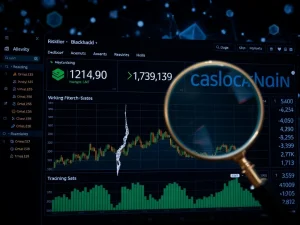Unleashing Katana DeFi: A Revolutionary Layer-2 Blockchain Debuts with $200M in Productive TVL

Are you ready for the next wave of decentralized finance innovation? The crypto world is buzzing with the arrival of Katana, a new DeFi-first layer-2 blockchain that just went live on its mainnet. This isn’t just another blockchain launch; Katana made a significant splash by debuting with an astounding $200 million in productive total value locked (TVL) even before its official public reveal. This remarkable entry positions Katana DeFi as one of the most capitalized layer-2 networks to launch this year, signaling a powerful shift in how we measure and utilize capital in the DeFi space.
What Makes Katana DeFi a Game-Changer?
Developed by the Katana Foundation and a proud graduate of the Polygon Agglayer Breakout Program, Katana is engineered to support high-yield decentralized finance activities at an institutional scale. Unlike many traditional models that rely heavily on issuing new tokens to attract participants, Katana’s approach is different. It integrates yields from multiple, robust sources, creating a more sustainable and efficient ecosystem.
Here’s how Katana is reshaping the landscape:
-
Integrated Yield Sources: Katana pulls yields from various avenues, including VaultBridge strategies, Chain-owned Liquidity (CoL) reserves, and AUSD-backed treasury flows. This multi-source strategy ensures diverse and resilient yield generation.
-
Native Asset Support: Through its launch partner, Universal, Katana enables direct onchain trading of popular non-Ethereum Virtual Machine (EVM) tokens such as SOL, XRP, and SUI. This broadens accessibility and utility within the Katana ecosystem.
-
Institutional Integration: Universal has also integrated with Coinbase Prime, providing institutional-grade custody and minting of supported assets. This removes the need for pre-seeded liquidity via decentralized exchanges, a significant step towards mainstream institutional adoption.
Katana also seamlessly integrates with established DeFi protocols like the decentralized exchange Sushi and the lending protocol Morpho, offering attractive incentives to liquidity providers. This strategic collaboration ensures deep liquidity and robust financial operations from day one.
Understanding the Power of Productive TVL
One of Katana’s most innovative contributions to the DeFi lexicon is its emphasis on ‘productive TVL’. This metric offers a clearer, more accurate picture of capital efficiency compared to traditional TVL, which often includes idle asset deposits. Productive TVL, as defined by Katana, only accounts for capital that is actively deployed into yield-generating strategies or core DeFi protocols.
Ahead of its mainnet launch, Katana accumulated over $200 million in this ‘productive TVL’, a testament to its design principles. Marc Boiron, CEO of Polygon Labs, highlighted the significance of this metric to Crypto News Insights, stating that it “provides a clearer picture of what’s really happening behind the scenes.” He added, “It reflects actual usage, economic efficiency, and long-term sustainability.”
Katana’s coordinated yield mechanisms transform passive capital into a self-circulating economic engine:
-
VaultBridge: This mechanism redirects bridged assets like Ether (ETH), USDC, USDt, and wBTC into offchain yield-bearing positions, primarily on Ethereum. The returns from these positions are then seamlessly looped back into Katana’s onchain DeFi pools, benefiting users who keep their assets in motion.
-
Chain-owned Liquidity (CoL): CoL ensures that sequencer fees generated on the network are continuously recycled back into liquidity reserves. This creates a self-sustaining loop that deepens liquidity over time.
Katana’s Role in the Layer-2 Blockchain Ecosystem
As a DeFi-first Layer-2 Blockchain, Katana is poised to play a crucial role in the broader blockchain ecosystem, particularly within the Polygon Agglayer. The Agglayer is Polygon’s ambitious vision for a unified, interoperable network of ZK-powered chains, and Katana is designed to be a key component within this architecture.
Marc Boiron emphasized that Katana’s primary objective is “to address the liquidity demands of the Agglayer ecosystem while meeting users’ needs for deeper liquidity and higher yields.” This means that assets on Katana are not merely sitting idle; they are actively deployed, generating real usage, sequencer fees, and app-level fees. These economic activities then flow back into sustaining even deeper DeFi liquidity across the network.
Katana’s strategic alignment with the Polygon Agglayer reinforces the modular Ethereum ecosystem, promoting greater efficiency and scalability for decentralized applications.
Boosting DeFi Liquidity and Yields for All
Katana is not just for institutions; it aims to provide robust DeFi liquidity and high yields for a broader audience. The platform’s design inherently seeks to maximize capital efficiency, ensuring that every dollar deposited is actively working to generate returns. This focus on productive capital utilization is a significant departure from traditional DeFi models that might have a large TVL but a smaller portion of that capital actively generating yield.
To further deepen its ties to the Polygon ecosystem and reward early supporters, Katana has earmarked approximately 15% of its native KAT token supply for an upcoming airdrop. This airdrop will benefit Polygon (POL) token stakers, including those holding liquid staking derivatives, incentivizing participation and fostering a strong community around the new network.
The launch of Katana also coincides with other significant DeFi infrastructure advancements, such as Agora’s AUSD. AUSD is a yield-bearing stablecoin that channels returns from US Treasury and repo markets directly into Katana’s protocols. These external yield flows, combined with Katana’s smart yield routing mechanisms, form the bedrock of its productive TVL model, creating a powerful synergy for users.
The Future of the Polygon Agglayer with Katana
Katana’s successful mainnet debut marks a pivotal moment for the Polygon Agglayer. Its innovative approach to liquidity management and yield generation is set to enhance the overall economic activity and efficiency within the Agglayer ecosystem. By focusing on ‘productive TVL’, Katana sets a new standard for evaluating the health and sustainability of DeFi protocols, moving beyond mere capital accumulation to actual capital utilization.
The synergy between Katana’s DeFi-first design, its integration with institutional partners, and its deep ties to the Polygon network creates a compelling vision for the future of decentralized finance. As more assets become actively deployed and generate real returns, Katana is poised to drive significant growth and innovation within the modular blockchain space.
Conclusion: A New Era for DeFi Capital Efficiency
Katana’s mainnet launch, backed by $200 million in productive TVL, is more than just a new blockchain; it’s a testament to a refined vision for DeFi. By prioritizing active capital deployment and sustainable yield generation, Katana is setting a new benchmark for efficiency and utility in the decentralized world. Its strategic integrations, focus on institutional-grade solutions, and commitment to the Polygon Agglayer ecosystem position it as a formidable player in the ongoing evolution of blockchain technology. For those seeking deeper liquidity and higher, more sustainable yields, Katana offers a compelling new avenue in the ever-expanding universe of decentralized finance.









